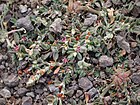Note: This is a project under development. The articles on this wiki are just being initiated and broadly incomplete. You can Help creating new pages.
Polygonum plebeium
Polygonum plebeium is a much-branched, prostrate annual plant with stems 4 - 45cm long. The plant is harvested from the wild for local use as a food and medicine.
Contents
[hide]- 1 Uses
- 2 Parts Used
- 3 Chemical Composition
- 4 Common names
- 5 Properties
- 6 Habit
- 7 Identification
- 8 List of Ayurvedic medicine in which the herb is used
- 9 Where to get the saplings
- 10 Mode of Propagation
- 11 How to plant/cultivate
- 12 Commonly seen growing in areas
- 13 Photo Gallery
- 14 References
- 15 External Links
Uses
Parts Used
Chemical Composition
It contais Alkaloids, Glycosides, Flavonoids, Volatile oils, tannins, resins, coumarins, and lignans, have also been isolated from Polygoneae species etc.[2]
Common names
| Language | Common name |
|---|---|
| Kannada | ಕೆಂಪು ನೆಲ ಅಕ್ಕಿ Kempu nela akki, ಸೀರನಿಗೆ ಸೊಪ್ಪು Siranige soppu |
| Hindi | Chimati saag, Lal buti |
| Malayalam | Peraraththa |
| Tamil | |
| Telugu | Chimati kura |
| Marathi | Gulabi godhadi |
| Gujarathi | Jhinko okharad |
| Punjabi | |
| Kashmiri | |
| Sanskrit | Sarpakshi, Sarpalochana |
| English | Common knotweed, Small knotweed |
Properties
Reference: Dravya - Substance, Rasa - Taste, Guna - Qualities, Veerya - Potency, Vipaka - Post-digesion effect, Karma - Pharmacological activity, Prabhava - Therepeutics.
Dravya
Rasa
Guna
Veerya
Vipaka
Karma
Prabhava
Habit
Identification
Leaf
| Kind | Shape | Feature |
|---|---|---|
Flower
| Type | Size | Color and composition | Stamen | More information |
|---|---|---|---|---|
| {{{5}}} |
Fruit
| Type | Size | Mass | Appearance | Seeds | More information |
|---|---|---|---|---|---|
Other features
List of Ayurvedic medicine in which the herb is used
Where to get the saplings
Mode of Propagation
How to plant/cultivate
When growing in dry places the leaves are said to develop a bitter flavour.[5]
Commonly seen growing in areas
Rocky ground, Drying mudflats along lakes.
Photo Gallery
References
- Jump up ↑ Indian Medicinal Plants by C.P.Khare
- Jump up ↑ Chemical constituents
- Jump up ↑ Common names
- Jump up ↑ [Morphology]
- Jump up ↑ Cultivation
External Links
- Ayurvedic Herbs known to be helpful to treat Bowel complaints
- Herbs with Leaves used in medicine
- Herbs with stem used in medicine
- Herbs with leaves used in medicine
- Herbs with Root used in medicine
- Herbs with common name in Kannada
- Herbs with common name in Hindi
- Herbs with common name in Malayalam
- Herbs with common name in Telugu
- Herbs with common name in Marathi
- Herbs with common name in Gujarathi
- Herbs with common name in Sanskrit
- Herbs with common name in English
- Habit - Annual
- Index of Plants which can be propagated by Seeds
- Herbs that are commonly seen in the region of Rocky ground
- Herbs that are commonly seen in the region of Drying mudflats along lakes
- Herbs
- Pages without herbs images



